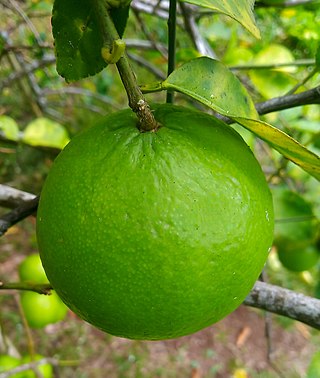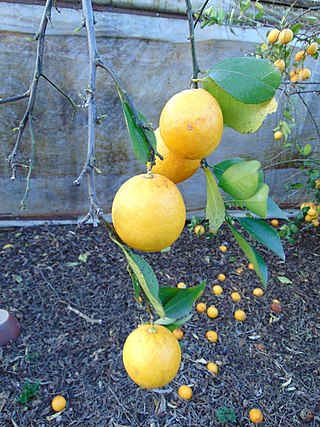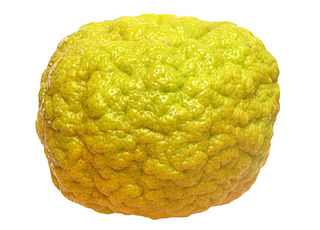Related Research Articles

Citrus is a genus of flowering trees and shrubs in the family Rutaceae. Plants in the genus produce citrus fruits, including important crops such as oranges, mandarins, lemons, grapefruits, pomelos, and limes.

Bonita is a census-designated place (CDP) in southern San Diego County, California, nestled between the cities of Chula Vista, National City, and San Diego. The population was 12,917 at the 2020 census, up from 12,538 at the 2010 census.

A margarita is a cocktail consisting of tequila, triple sec, and lime juice. Some margarita recipes include simple syrup as well and are often served with salt on the rim of the glass. Margaritas can be served either shaken with ice, without ice, or blended with ice. Most bars serve margaritas in a stepped-diameter variant of a cocktail glass or champagne coupe called a margarita glass. The margarita is one of the world's most popular cocktails and the most popular tequila-based cocktail.

Citrus cavaleriei, the Ichang papeda, is a slow-growing species of papeda that has characteristic lemon-scented foliage and flowers.

Etrog is the yellow citron used by Jews during the weeklong holiday of Sukkot as one of the four species. Together with the lulav, hadass, and aravah, the etrog is taken in hand and held or waved during specific portions of the holiday prayers. Special care is often given to selecting an etrog for the performance of the Sukkot holiday rituals.

Pollination of fruit trees is required to produce seeds with surrounding fruit. It is the process of moving pollen from the anther to the stigma, either in the same flower or in another flower. Some tree species, including many fruit trees, do not produce fruit from self-pollination, so pollinizer trees are planted in orchards.

The citron, historically cedrate, is a large fragrant citrus fruit with a thick rind. It is said to resemble a 'huge, rough lemon'. It is one of the original citrus fruits from which all other citrus types developed through natural hybrid speciation or artificial hybridization. Though citron cultivars take on a wide variety of physical forms, they are all closely related genetically. It is used in Asian and Mediterranean cuisine, traditional medicines, perfume, and religious rituals and offerings. Hybrids of citrons with other citrus are commercially more prominent, notably lemons and many limes.

The pomelo, also known as a shaddock, is the largest citrus fruit. It is an ancestor of several cultivated citrus species, including the bitter orange and the grapefruit. It is a natural, non-hybrid, citrus fruit, native to Southeast Asia. Similar in taste to a sweet grapefruit, the pomelo is commonly eaten and used for festive occasions throughout Southeast and East Asia. As with the grapefruit, phytochemicals in the pomelo have the potential for drug interactions.

Citrus × meyeri, the Meyer lemon, is a hybrid citrus fruit native to China. It is a cross between a citron and a mandarin/pomelo hybrid.

The Key lime or acid lime is a citrus hybrid native to tropical Southeast Asia. It has a spherical fruit, 2.5–5 centimetres in diameter. The Key lime is usually picked while it is still green, but it becomes yellow when ripe.

The oroblanco, oro blanco, or sweetie is a citrus hybrid, resulting from a cross between an acidless pomelo and a Marsh grapefruit. Its fruit is oblate and mostly seedless, with a thick rind that remains green long after it has already matured. It has a sweet, mild taste, and lacks the bitterness generally associated with grapefruit. It requires less heat to grow than other varieties of grapefruit and are harvestable sooner. Oroblancos grown in moderate climates tend to yield the highest-quality fruit.

The orange, also called sweet orange to distinguish it from the bitter orange, is the fruit of a tree in the family Rutaceae. Botanically, this is the hybrid Citrus × sinensis, between the pomelo and the mandarin orange. The chloroplast genome, and therefore the maternal line, is that of pomelo. There are many related hybrids including of mandarins and sweet orange. The sweet orange has had its full genome sequenced.

The ponderosa lemon is a citrus hybrid of a pomelo and a citron. It is not the same as the 'Yuma Ponderosa' lemon-pomelo hybrid used as citrus rootstock.

Eliza Tibbets was among early American settlers and founders of Riverside, California; she was an activist in Washington, D.C., for progressive social causes, including freedmen's rights and universal suffrage before going to the West Coast. A spiritualist, she led seances in Riverside. She became known for successfully growing the first two hybrid Washington navel orange trees in California.

The lemon is a species of small evergreen tree in the Citrus genus of the flowering plant family Rutaceae. The lemon is a hybrid of the citron and the bitter orange. Its origins are uncertain, but some evidence suggests lemons originated during the 1st millennium BC in what is now northeastern India.

Lemonade fruit, otherwise known as Lemonade lemon, New Zealand lemonade or Unlemon is a variety of sweet lemon citrus fruit, believed to be a hybrid between a mandarin orange and a lemon.
Limoneira is a public limited agribusiness and real estate development company based in Santa Paula, California, United States. The Company's operations mainly consist of production, sales and marketing of citrus and avocados. The company's real estate holdings and vast water rights support three business segments which are agribusiness, rental operations and real estate development. The company received the IPM Innovator Award at California Legislature Assembly Resolution.
Micro-budding is a grafting technique used in the development of citrus trees. Like traditional grafting, there is a combination the hardy characteristics of a rootstock with the desired fruit of the budded region; however, micro-budding is done at a younger age, and because of apical hormonal dominance, the resulting citrus trees grow faster and bear fruit at an earlier stage than traditional T-budded grafted trees. It was developed in 1997 by Dr. Mani Skaria, a citrus scientist (retired) from the Texas A&M University - Kingsville Citrus Center.

The New Zealand grapefruit, also known as the Poorman, Poorman orange, poorman's orange, poor man's orange, and goldfruit, is a type of citrus fruit grown in New Zealand. Despite its name, it is not genetically a true grapefruit, but rather is believed to be a hybrid between a pomelo and a mandarin or tangelo.

Pompia, also called pumpia, sa pompia, spompia, and China citron, is a Citrus hybrid cultivated for its edible fruit. It is a taxonomical synonym of Citrus medica.
References
- 1 2 3 4 Official Report of the Eleventh Fruit Growers Convention of the State of California, 1889
- 1 2 3 “It’s Fairly Easy to Get Bored Around Here,” San Diego Reader, Oct. 18, 2007
- ↑ Types List, http://typeslist.com
- ↑ “Bonnie Brae – Eating and Digesting the Soil – How the Bonnie Brae Lemon was Originated,” The Great Southwest, September 1889
- ↑ “The Orange: Its Culture in California; with a Brief Discussion of the Lemon, Lime and Other Citrus Fruits,” Press and Horticulturist Steam Print, Riverside, California, 1885
- 1 2 “Images of America: Bonita,” by Steven Schoenherr, Mary E. Oswell, and the Bonita Museum and Cultural Center, Arcadia Publishing, Charleston, SC, 2009
- ↑ “Fifty Year Old Lemon Orchard, Example of Longevity,” California Citrograph, Vol. 4; December 1918